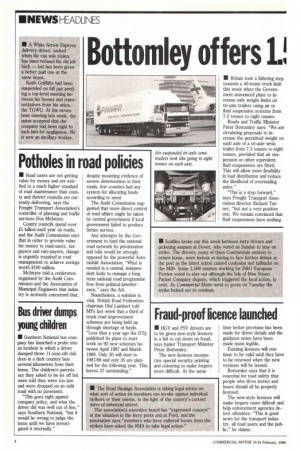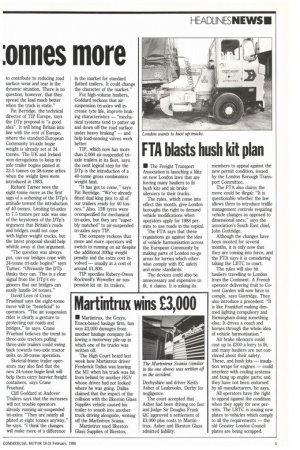Bottomley offers 1.1 mines ore
Page 8

Page 9

If you've noticed an error in this article please click here to report it so we can fix it.
• Britain took a faltering step towards a 40-tonne truck limit this week when the Government announced plans to increase axle weight limits on tri-axle trailers using air or fluid suspension systems from 7.5 tonnes to eight tonnes.
Roads and Traffic Minister Peter Bottomley says: "We are circulating proposals to increase the permitted weight on each axle of a tri-axle semitrailer from 7.5 tonnes to eight tonnes, provided that air suspension or other equivalent fluid suspensions are fitted. This will allow more flexibility in load distribution and reduce the likelihood of overloading axles."
"This is a step forward," says Freight Transport Association director Richard Turner, "but not a very positive one. We remain convinced that fluid suspensions have nothing to contribute to reducing road surface wear and tear in the dynamic situation. There is no question, however, that they spread the load much better when the truck is static."
Pat Berridge, the technical director of TIP Europe, says the DTp proposal is "a good idea". It will bring Britain into line with the rest of Europe, where the standard European Community tri-axle bogie weight is already set at 24 tonnes. The UK and Ireland won derogations to keep triaxle trailer bogies pinned at 22.5 tonnes on 38-tonne artics when the weight laws were introduced in 1983.
Richard Turner sees the eight-tonne move as the first sign of a softening of the DTp's attitude toward the introduction of 40 tonnes. Limiting tri-axles to 7.5 tonnes per axle was one of the keystones of the DTp's argument that Britain's roads and bridges could not cope with higher-weight trucks, but the latest proposal should help whittle away at that argument.
"The question was always put, can our bridges cope with 24-tonne tri-axle bogies?" says Turner. "Obviously the DTp thinks they can. This is a clear signal from the DTp's engineers that our bridges can easily handle 24 tonnes."
David Lees of Crane Fruehauf says the eight-tonne move will be "beneficial" to operators. "The air suspension rider is clearly a gesture to protecting our roads and bridges," he says. Crane Fruehauf believes the trend to three-axle tractors pulling three-axle trailers could swing back towards two-axle tractor units on 38-tonne operation.
Skeletal-frame trailer operators may also find that the new 24-tonne bogie limit will help them carry heavier freight containers, says Crane Fruehauf, Cliff Goddard at Andover Trailers says that the increases will not trouble operators already running air-suspended tri-axles: "They are nearly all plated at eight tonnes anyway," he says. "I think the changes will make more of a difference in the market for standard flatbed trailers. It could change the character of the market."
For high-volume hauliers, Goddard reckons that airsuspension tri-axles will increase tyre life, improve braking characteristics — "mechanical systems tend to patter up and down off the road surface under heavy braking" — and help load-sensing valves work better.
TIP, which now has more than 2,000 air-suspended triaxle trailers in its fleet, says the next logical step for the DTp is the introduction of a 40-tonne gross combination weight limit.
"It has got to come," says Pat Berridge. "We've already fitted dual king pins to all of our trailers ready for 40 tonnes." Also, 15R tyres were overspecified for mechanical tri-axles, but they are "superbly matched" to air-suspended tri-axles says TIP.
The company reckons that more and more operators will switch to running on air despite the additional 300kg weight penalty and the extra cost involved — usually at a cost of around 21,800.
TIP specifies Rubery-Owen Rockwell's Weweller air suspension kit on its trailers.
























































































